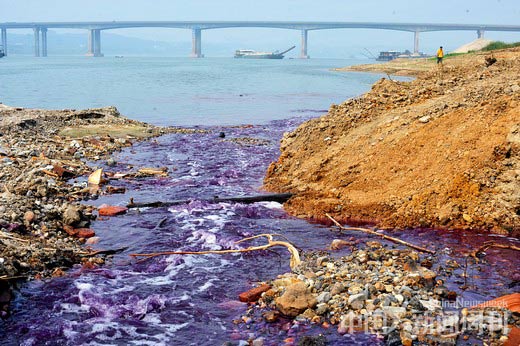
Contaminated water is running into the Xiangjiang River on September 17, 2011.
(Ecns.cn) – The Xiangjiang River is China's first region approved by the State Council to be treated for heavy metal pollution with a comprehensive plan, yet the cleanup effort has encountered numerous problems and the Xiangjiang remains one of the country's most polluted waterways, notes China Newsweek.
Due to the contamination of vast tracts of land along the banks of the Xiangjiang, rice and vegetables grown there always contain excessive heavy metals, causing the government to impose a ban on farming.
The rampant pollution has dramatically changed the lifestyles of most local residents, many of whom have abandoned their farms in the hopes that the environment will one day be restored. However, it has been discovered that many factories are still disposing of industrial effluents into the river.
Compared to the cleanup efforts of other rivers, recovering the Xiangjiang is an especially significant project, by which the government hopes to hew a path in the management of industrial heavy metal pollutants.
Poisoned farms
During the two top political sessions that concluded last month, issues such as drinking water safety, the structural transformation of the economy, ecosystem restoration and industrial zone relocation – all of which involve the problem of heavy metal pollution – were raised by many participants.
In Central China's Hunan Province, toxic chemicals have long threatened the safety of soil and drinking water in the downstream regions of the Xiangjiang River.
Last year, a 7-year-old girl died two years after being diagnosed with cadmium poisoning. She was buried just 100 meters from the Xiangjiang, which was believed to be the main source of the heavy metal that killed her. In addition to the girl, some 150 villagers have also been poisoned by cadmium.
Liu Hai, 54, a local farmer, pointed to the barren land in front of his house and recalled that it was once a fertile plain. He told China Newsweek that he likes farming, but that the government has asked him not to because the land has been contaminated by toxic cadmium.
Now Liu receives a stipend from a nearby industrial site of 1,100 yuan (US$174) per mu (0.067 hectare) for each season of rice production. He has been unwilling to give up the habit of farm work, however, so he rents a plot of land in a neighboring village.
To avoid the pollution, Liu has stopped using water from the Xiangjiang. Instead, he irrigates his farmland with water from a lake located far away from the embattled river.
Liu revealed with contempt that some of the local villagers had found jobs at the industrial site, but that he will never go there.
Sharing the river
In Hunan, a lack of regulation and environmental consciousness has resulted in the expanding production of nonferrous metals, which are a major source of toxic pollution in the province.
The Xiangjiang River supports 60 percent of the province's population and 70 percent of its industrial output, and it is now one of the most polluted waterways in China.
Because the river runs through Changsha, Xiangtan and Zhuzhou, the three cities have been cooperating for years to tackle the invasion of heavy metals.
However, the cities have encountered a number of unexpected problems caused by urban expansion and rapid industrialization that threaten the water supply.
Under much pressure, local governments have all increased the frequency of water quality monitoring along the Xiangjiang in an effort to detect heavy metal pollutants. Xiangtan, for example, is now taking samples from the river every ten days, whereas the sampling was only conducted monthly in the past.
Despite such measures, local residents still worry about possible threats from the drinking water to their health, so many now take samples of their own and report problems if there are any.
According to China Newsweek, a large number of residents in Xiangtan have traveled in secret to take samples of the Xiangjiang in Zhuzhou, where some have reported abnormal water quality to the Zhuzhou Environmental Protection Agency.
The sensitive issue has caused tempers to flare. In a fit of rage, a deputy to the People's Congress of Xiangtan once banged his fist on the table in response to the director of the Zhuzhou Environmental Protection Agency over the deterioration of the Xiangjiang.
Hard to control
According to data from the Chinese Academy of Sciences, 715,000 hectares of land in Hunan, or roughly 3.4 percent of the province's total area, is contaminated by heavy metals.
A study conducted by the Ministry of Land and Resources in Hunan identified elevated levels of heavy metals in a 250 kilometer by 10 kilometer belt adjacent to Dongting Lake, China's second largest freshwater lake. Nearby crops, reeds and shellfish were found to have been contaminated by cancer-causing cadmium.
To avoid investigation, some highly polluting factories are relocating to small towns or other provinces that are more loosely regulated in terms of heavy metal pollution, says China Newsweek.
Though the Hunan Provincial Environmental Protection Agency has rolled out tighter regulations, including a higher access standard for pollution-prone enterprises and stiffer penalties for violators, the polluting behavior is still hard to track.
According to a study by Nanjing Agricultural University, about 10 percent of China's rice was tainted by cadmium last year, and most of it was harvested in Hunan Province.

Copyright ©1999-2011 Chinanews.com. All rights reserved.
Reproduction in whole or in part without permission is prohibited.